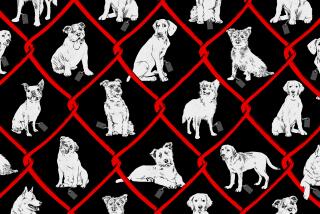Sled-Dog Mushers Battle Charges of Animal Cruelty
- Share via
ANCHORAGE — In the world of dog-sled racing, it is known as “culling”--weeding out the dogs too big, too aggressive or too old to make the team.
The dog owners call it a humane process. But detractors say that is not always the case.
In September, two-time Iditarod racer Frank Winkler was charged with 14 counts of animal cruelty after a crate full of dead and dying puppies was found in the back of his pickup truck. Prosecutors say Winkler hit the puppies over the head with the blunt end of an ax. His trial is set for Dec. 11.
Winkler has said in court documents that he shot some of the dogs--a kinder method, according to veterinarians--and that he was just following advice from fellow racers, known as mushers. He said he couldn’t afford to take the puppies to a veterinarian to be put to sleep.
“He’s young in this business,” said Winkler’s attorney, Ben O. Walters. “He just did what he was told was common.”
Mushers deny that such actions are common and contend that the uneducated in their ranks are ruining the sport’s good name. But executives at the Humane Society of the United States say such cases confirm their worst fears.
“We believe that the culling and killing of surplus sled dogs and animals that are bred for racing is much broader and much more widespread” than the industry admits, said society Vice President David Wills in Washington, D.C. “It’s the ugly side of the industry.”
The 1,163-mile Iditarod, known as the Last Great Race on Earth, usually lasts from 11 days to two weeks. About a third of the 1,500 dogs that start the race are flown out because they become sick, injured or exhausted. At least one or two dogs die in each Iditarod, most from pneumonia, intestinal obstructions and “sudden death syndrome”--dropping in harness for unknown reasons.
Veterinarians say mushers should let professionals put unsuitable animals to sleep. But vets can be expensive, and in Alaska, getting to one isn’t always possible.
“Everybody agrees that an ax handle is not the way to do it,” said Sherri Hayden, who owns a wilderness lodge in remote central Alaska with her husband, Jack, and offers recreational mushing. “But we know that (breeding) accidents do happen, and you need to take care of them.
“We’d like to have people talk about it a little more so that they know how to put their puppies down without being cruel.”
Mushers argue that questions of humane treatment and euthanasia are complicated ones that exist outside mushing as well. And they are calling for better education to clean up the sport and its image.
“My dogs receive much better care than most pet or family dogs,” said five-time Iditarod champion Rick Swenson, who started a newsletter this summer to tell fans about himself and good dog care.
“Mushers--especially new ones--always need more education. But in the same respect, the public and especially the people that make up the Humane Society need to be educated,” Swenson said.
Four-time Iditarod winner Susan Butcher said she welcomes the new spotlight cast on mushing’s darker corners. She told mushers at a recent symposium in Fairbanks that the few who mistreat dogs make everybody look bad.
Now Butcher says she and her husband, musher Dave Monson, are interested in forming a voluntary mushing organization that would set general dog-care standards and possibly even allow for inspection.
Butcher said there are mushers who think wrongly that they have to breed a lot of dogs from which to select their top athletes.
Puppies are put in harness at about six to seven months so owners can see which ones like to pull and are good at it. Some owners hook them right up to sleds, while others have the dogs drag logs or tires across a yard.
Temperament, size and gait determine which pups make the cut. Dogs that fight with people or other dogs are weeded out, as are larger dogs, which are thought to be more injury-prone.
Top racers like Swenson and Butcher can maintain large kennels and have relatively little difficulty selling puppies to other mushers trying to build good teams. They say they emphasize birth control to avoid too many litters.
Hayden said her veterinarians give her a drug to euthanize dogs if necessary. She said she tries to prevent unwanted litters by keeping females in heat penned up, but this year had to euthanize two puppies of a litter of five.
Veterinarians say taking responsibility for the animals--even if that means killing them--is humane, as long as death is instantaneous.
Karen Schmidt, a musher and head veterinarian for the 1992 Iditarod, said she is angered by the number of dogs and cats abandoned by the public at large and believes mushers do better by their animals than many pet owners.
“Yes, there are some individuals out there, the way there are in any walk of life, that don’t take the care and attention of their dogs--or their kids--that we would like to see,” she said.
“But there are those of us who really care. There are people setting very high standards for dog care. Lots of them.”
More to Read
Sign up for Essential California
The most important California stories and recommendations in your inbox every morning.
You may occasionally receive promotional content from the Los Angeles Times.













